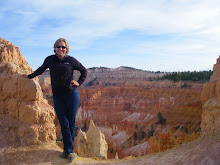I scrambled to the top of the park's Black Mesa at work this morning. With super-steep slopes and a broad, flat top, this black formation juts out of the lake shore landscape, imposing enough to entice the soil surveyors to describe the unique soil type on top. And, wherever the soil scientists went, Teague and I must follow and count the plants in their wake.
But the soil is not the point. The point is that on the broad, kansas-style flat summit that rewarded our strenuous, rocky climb, we met a snake. We chased him around for a bit, trying to make introductions and take pictures, but he wasn't having it. It is my botanist's opinion (armed with field guide) that it was a Racer, Coluber constrictor. He was fast, anyway. But, more importantly, he was on top of this mesa. We barely made the climb, how the hell did he?
My first theory was that he had wiggled free from the talons of a raptor flying above the mesa, but he seemed too....intact....to have survived such an adventure. So he must have climbed. Or his mother did, at least. Now, I know that snakes live in the mountains, I've seen my share of rock-dwelling rattlers this summer. I also know that snakes can climb trees, I've seen the hognose snakes in Virginia (Heterodon platirhinos), short, fat, pugnacious fellows that sun in the tree branches alongside the creeks. They are hard to miss, because if you startle them, paddling past in your canoe, minding your business, they may jump in to join you, and not sociably.
But how do snakes climb up mountains? The answer is known the herpetologists and perhaps their friends, is called Concertina movement. As opposed to the traditional snake motion, the aptly named serpentine glide, and it's sandy variation, sidewinding, concertina allows the snake move vertically. She stretches her head up as high as she can, and slides it into a position where her ventral scales can grip on the surface. To enhance her grip, she pulls her midsection up tightly, to wind a lot of scale-surface area onto the rocks. Then, she uses this firm grip to pull up her lower body, and lastly springs her head upward again, looking for her next, higher hold.
Sounds like a tedious process, but it also sounds a lot like how I climbed the Black Mesa. One good move at a time, at least in the steepest parts. Snakes, despite their lack of limbs, are actually showoffs in the range of motion category. They can slide, swim, climb, and in fact, fly. Well, to be totally honest, they only glide. But several species in southeast asia are known for jumping out of trees and flattening out their ribcages to hold onto a draft as they serpentine-squiggle through the air. Apparently they have adapted to get pretty far with this technique. Maybe my racer didn't even need to climb?
4 years ago


No comments:
Post a Comment